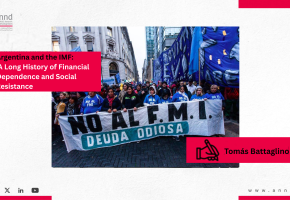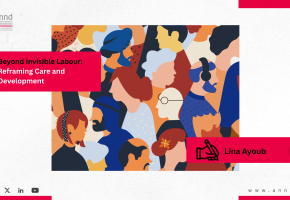
The Global Financial System is Out of Sync with Development: Evidence from Tunisia - Rawan Al Gharib

The Global Financial System is Out of Sync with Development: Evidence from Tunisia - Rawan Al Gharib
Introduction:
Debt accumulation in developing countries is often attributed to internal factors such as fiscal mismanagement, corruption, and economic instability i. However, a closer examination reveals that the shape of the Global Financial System plays a far more critical role. This power imbalance within the global financial architecture significantly influences the recurring debt crises that undermine development and human rights.
Global financial institutions like the International Monetary Fund (IMF) and the World Bank (WB) hold significant power over borrowing nations, particularly during crises when they provide loans with strict conditions. These conditions often include structural adjustment programs (SAPs) that enforce austerity measures and privatization, leading to severe social and economic impacts such as cuts to essential public services, increased poverty, and inequality. The human cost of these policies highlights how the interests of lenders often overshadow the development needs and rights of the borrowing countries. High borrowing costs and debt servicing burdens further hinder development as resources are diverted from crucial investments in infrastructure, healthcare, and education, perpetuating poverty. Additionally, the power imbalance in negotiations favors lenders, resulting in agreements that reinforce debt dependency and limit the borrowing nations' development prospects.
Global Debt Crises: Historical Overview
Debt crises have been a recurring feature of the global economy, largely due to external pressures. In the 19th century, Latin American and European nations faced crises exacerbated by harsh lending conditions from foreign creditors. The 1930s Great Depression saw widespread defaults as global trade collapsed and capital flows reversed. Post-World War II, developing countries accrued debt under stringent conditions set by international financial institutions. The 1980s Latin American debt crisis was driven by high global interest rates and falling commodity prices. The 1990s witnessed the Asian financial crisis, precipitated by sudden capital flight and currency speculation, and the Russian default, influenced by global market dynamics. The early 2000s featured Argentina's debt crisis, while the 2008 global financial crisis triggered sovereign debt crises in the Eurozone. The 2010s were dominated by the Eurozone debt crisis and emerging market challenges. The COVID-19 pandemic in the 2020s resulted in significant borrowing under unfavorable terms, highlighting ongoing concerns about debt sustainability due to external economic shocks and stringent global financial conditions.
Failure of the GFS: Evidence from Tunisia
Following the 2010-11 Jasmine revolution, The IMF approved a two-year SBA for Tunisia in June 2013, an Extended Fund Facility (EFF) in May 2016, and Rapid Financing Instrument (RFI) in April 2020 aiming at stabilizing the economy, reducing fiscal and external imbalances and promoting growthii. Despite being a diligent recipient of IMF assistance, Tunisia continues to face socio-economic challenges, including income disparities and high unemployment, especially among the youth.
Table 1: Unemployment rates, 2022
| Country/Region |
Unemployment, youth total (% total labor force) |
| Tunisia |
40.60% |
| MENA |
25% |
| World |
14.30% |
Table 1 shows that Tunisia faces significant economic challenges, with a youth unemployment rate of 40.6%, far exceeding the MENA region's average of 25% and the global rate of 14.3%. The disconnect between IMF loans aimed at increasing GDP growth and the persistent high unemployment in Tunisia highlights the prevalence of the joblessness problem, where macroeconomic growth does not automatically translate into job creation and reduced unemployment. Tunisia’s adherence to stringent conditions such as subsidy reductions, public spending controls, and tax reforms has resulted in considerable short-term hardships for its population, particularly among lower and middle-income groups. These measures, while aimed at restoring economic stability, have disproportionately affected vulnerable demographics, including youth, amplifying economic disparities and social tensions.
Table 2: Net Personal Wealth and Pre-tax National Income, 2022
| Net Personal Wealth |
Net Personal Wealth | Pre-tax National Income |
Pre-tax National Income |
|
| Bottom 50% |
Top 10% |
Bottom 50% |
Top 1% |
|
| Tunisia |
16.60% |
41.40% |
48.80% |
58% |
| MENA |
9.20% |
57% |
1.30% |
75.70% |
| World |
8% |
53.20% |
1.90% |
75.90% |
Notes: Wealth denotes net personal wealth, computed as the total value of non-financial and financial assets (housing, land, deposits, bonds, equities, etc.) held by households (age 20+) minus their debts. Pre-tax national income is the sum of all pre-tax personal income flows accruing to labor (20+) and capital before tax but after accounting for pension.
The bottom 50% of the population holds 16.6% of the nation’s wealth, while the top 10% controls 41.4%. Income distribution is even more skewed, with the top 1% earning 58% of pre-tax national income, compared to 48.8% for the bottom 50%. These figures highlight severe disparities in both wealth and income, indicating that IMF-backed reforms have not sufficiently addressed the underlying economic inequalities.
This pattern of inequality is also prevalent globally and regionally: in the MENA region, the bottom 50% holds only 9.2% of wealth while the top 10% controls 57%, and globally, the bottom 50% holds just 8% of wealth compared to 53.2% for the top 10%.. Similarly, in terms of income, the bottom half in the MENA region earns only 1.3% of pre-tax income, while the top 10% earns 43.7%. Globally, the pre-tax income shifts slightly to 1.9% for the bottom half and 38.4% for the top 10%. These figures highlight the pervasive nature of economic inequality and suggest that global financial institutions have failed to implement policies that effectively address and reduce these disparities, underscoring the need for more inclusive and equitable economic strategies worldwide.
The data highlights how the global financial system is out of sync with the developmental needs of individuals and societies. This system often prioritizes macroeconomic indicators like GDP growth, inflation rates, and fiscal deficits while neglecting human development issues such as high unemployment, especially among youth, and inadequate public services.
Conclusion:
Rich and developed countries must understand that reforming the global financial system is both a moral imperative and an economic necessity that benefits everyone. Sustainable development and increased economic equality in developing countries contribute to a more stable and resilient global economy. Conversely, the lack of reforms heightens the risk of defaults and social unrest. By aligning the global financial system with the development needs of all nations, we create a win-win scenario: promoting equitable growth and stability for developing countries while protecting the developed nations’ economic and security interests. Enhancing global cooperation through multilateral partnerships, aligning financial policies with shared development goals, and fostering transparency in agreements is essential for tackling the interconnected challenges of our time. Encouraging the involvement of Civil Society Organizations (CSOs) in advocacy and monitoring will further promote fair financial practices and amplify the voices of local communities, creating a more equitable and sustainable global future.
Rawan Al Gharib
This article is part of a series written by participants of Global South Study Week 2024 and does not necessarily reflect the views of ANND.
References
World Bank Group. Global Waves of Debt: Causes and Consequences. World Bank, April 24, 2024. https://pubdocs.worldbank.org/en/377151575650737178/Debt-Chapter-1.pdf
“World Development Indicators | DataBank.” https://databank.worldbank.org/source/world-development-indicators.
WID - Wealth and Income Database. “Home - WID - World Inequality Database.” WID - World Inequality Database. Last modified January 19, 2022. https://wid.world/.
IMF Country Report No. 20/103: Request for Purchase Under the Rapid Financing Instrument IMF. Last modified January 19, 2022. https://www.imf.org/-/media/Files/Publications/CR/2020/English/1TUNEA2020001.ashx
i https://pubdocs.worldbank.org/en/377151575650737178/Debt-Chapter-1.pdf
ii https://www.imf.org/-/media/Files/Publications/CR/2020/English/1TUNEA2020001.ashx
Recent publications

